Market
South Korea Unveils North Korea’s Role in Upbit Hack

According to local media, South Korea confirmed that North Korea was behind the theft of 342,000 Ethereum (ETH) tokens. The 2019 loot, worth approximately 58 billion Won or $41.5 million, was stolen from the Upbit crypto exchange.
The stolen tokens, now valued at 1.47 trillion Won, represent one of the largest cryptocurrency heists attributed to North Korea.
North Korea’s Involvement Uncovered
Per the report, the National Investigation Headquarters of South Korea’s National Police Agency announced on November 21 that two North Korean hacking groups, Lazarus and Andariel, orchestrated the attack. Both groups are known affiliates of North Korea’s Reconnaissance General Bureau, a state agency linked to cyber espionage and financial crimes.
Investigators relied on a combination of digital forensics, including tracking IP addresses and analyzing the flow of stolen cryptocurrencies. The probe also identified linguistic traces of North Korean vocabulary.
“It was revealed that traces of the North Korean term ‘Heulhan Il’ (a word meaning ‘unimportant matter’) were found on the computer used in the attack at the time,” another local Korean media corroborated.
This linguistic fingerprint, alongside other technical evidence, strengthened the case against North Korea. According to the report, the US Federal Bureau of Investigation (FBI) police also aided the investigation. They provided additional evidence linking the attack to North Korea.
Following the theft, the perpetrators exchanged 57% of the stolen Ethereum for Bitcoin on three cryptocurrency exchanges believed to be operated by North Korea. These transactions happened at prices 2.5% below market value, presumably to expedite the sale. They then distributed the remaining Ethereum across 51 overseas exchanges and laundered them to obscure its origins.
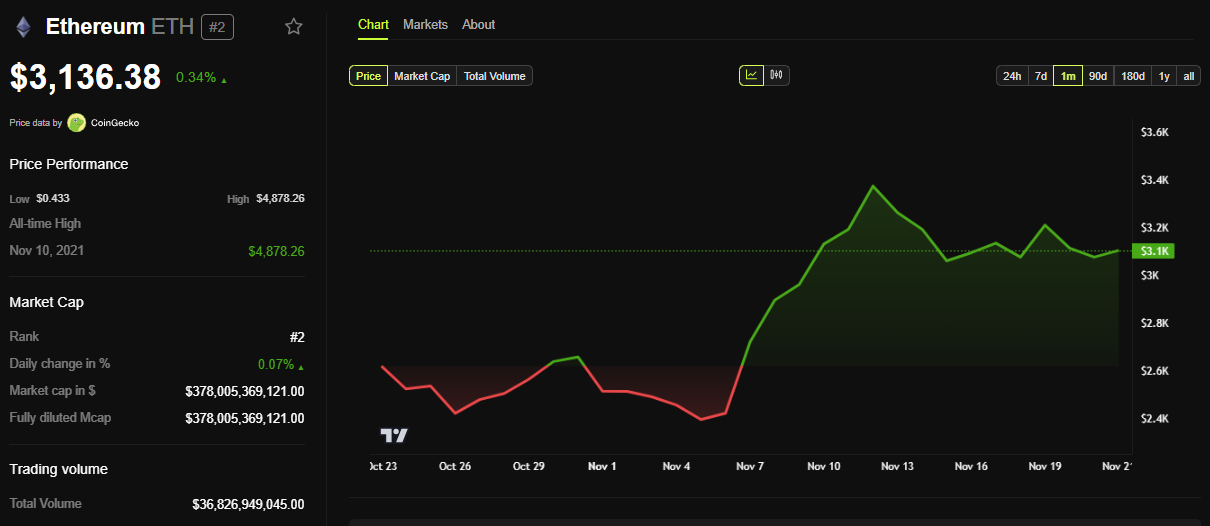
In 2020, some of the stolen cryptocurrency was identified at a Swiss crypto exchange. After a four-year effort to prove its source to Swiss prosecutors, South Korean authorities recovered 4.8 Bitcoin (BTC), worth around 600 million won. The recovered funds were later returned to Upbit in October 2024.
Concerns Over North Korea and Upbit Woes
Meanwhile, North Korea’s involvement in cryptocurrency crimes is not new. After a series of reports, authorities have noted a shift in tactics. As BeInCrypto reported recently, hackers linked to the regime are increasingly targeting crypto firms with sophisticated methods. Among the most prevalent techniques are phishing campaigns and supply chain attacks.
“The campaign, which we dubbed ‘Hidden Risk’, uses emails propagating fake news about cryptocurrency trends to infect targets via a malicious application disguised as a PDF file,” a recent report read.
This change of tact highlights the urgency for heightened cybersecurity measures across the industry. Notwithstanding, the confirmation of North Korea’s involvement in the 2019 Upbit hack marks a significant development.
While the United Nations (UN) and foreign governments have previously accused North Korea of funding its weapons programs through crypto theft, this is the first time South Korean authorities have officially linked the regime to a major cryptocurrency heist. The incident highlights the dual vulnerabilities facing the cryptocurrency industry.
First, external threats from state-sponsored hackers and, second, internal risks tied to inadequate regulatory compliance. Against the latter, and as BeInCrypto reported, South Korea’s Financial Intelligence Unit recently cited concerns about inadequate user verification systems. Specifically, the unit flagged over 600,000 potential KYC violations at Upbit, South Korea’s largest cryptocurrency exchange.
The discovery of mass KYC violations at Upbit raises questions about whether exchanges are doing enough to prevent illicit activities. Improved oversight, combined with stricter enforcement of anti-money laundering (AML) measures, could help deter future attacks and ensure a safer trading environment for investors.
The exchange is also facing an antitrust investigation by South Korea’s Fair Trade Commission, which is examining potential abuses of market dominance.
Disclaimer
In adherence to the Trust Project guidelines, BeInCrypto is committed to unbiased, transparent reporting. This news article aims to provide accurate, timely information. However, readers are advised to verify facts independently and consult with a professional before making any decisions based on this content. Please note that our Terms and Conditions, Privacy Policy, and Disclaimers have been updated.
Market
XRP Price Fate Hangs on $2.00—Major Move Incoming?

Aayush Jindal, a luminary in the world of financial markets, whose expertise spans over 15 illustrious years in the realms of Forex and cryptocurrency trading. Renowned for his unparalleled proficiency in providing technical analysis, Aayush is a trusted advisor and senior market expert to investors worldwide, guiding them through the intricate landscapes of modern finance with his keen insights and astute chart analysis.
From a young age, Aayush exhibited a natural aptitude for deciphering complex systems and unraveling patterns. Fueled by an insatiable curiosity for understanding market dynamics, he embarked on a journey that would lead him to become one of the foremost authorities in the fields of Forex and crypto trading. With a meticulous eye for detail and an unwavering commitment to excellence, Aayush honed his craft over the years, mastering the art of technical analysis and chart interpretation.
As a software engineer, Aayush harnesses the power of technology to optimize trading strategies and develop innovative solutions for navigating the volatile waters of financial markets. His background in software engineering has equipped him with a unique skill set, enabling him to leverage cutting-edge tools and algorithms to gain a competitive edge in an ever-evolving landscape.
In addition to his roles in finance and technology, Aayush serves as the director of a prestigious IT company, where he spearheads initiatives aimed at driving digital innovation and transformation. Under his visionary leadership, the company has flourished, cementing its position as a leader in the tech industry and paving the way for groundbreaking advancements in software development and IT solutions.
Despite his demanding professional commitments, Aayush is a firm believer in the importance of work-life balance. An avid traveler and adventurer, he finds solace in exploring new destinations, immersing himself in different cultures, and forging lasting memories along the way. Whether he’s trekking through the Himalayas, diving in the azure waters of the Maldives, or experiencing the vibrant energy of bustling metropolises, Aayush embraces every opportunity to broaden his horizons and create unforgettable experiences.
Aayush’s journey to success is marked by a relentless pursuit of excellence and a steadfast commitment to continuous learning and growth. His academic achievements are a testament to his dedication and passion for excellence, having completed his software engineering with honors and excelling in every department.
At his core, Aayush is driven by a profound passion for analyzing markets and uncovering profitable opportunities amidst volatility. Whether he’s poring over price charts, identifying key support and resistance levels, or providing insightful analysis to his clients and followers, Aayush’s unwavering dedication to his craft sets him apart as a true industry leader and a beacon of inspiration to aspiring traders around the globe.
In a world where uncertainty reigns supreme, Aayush Jindal stands as a guiding light, illuminating the path to financial success with his unparalleled expertise, unwavering integrity, and boundless enthusiasm for the markets.
Market
Ethereum Price Weakens—Can Bulls Prevent a Major Breakdown?

Reason to trust

Strict editorial policy that focuses on accuracy, relevance, and impartiality
Created by industry experts and meticulously reviewed
The highest standards in reporting and publishing
Strict editorial policy that focuses on accuracy, relevance, and impartiality
Morbi pretium leo et nisl aliquam mollis. Quisque arcu lorem, ultricies quis pellentesque nec, ullamcorper eu odio.
Ethereum price started another decline and traded below the $1,880 level. ETH is now consolidating and remains at risk of more losses.
- Ethereum struggled to continue higher above the $2,000 resistance level.
- The price is trading below $1,880 and the 100-hourly Simple Moving Average.
- There is a connecting bearish trend line forming with resistance at $1,820 on the hourly chart of ETH/USD (data feed via Kraken).
- The pair must clear the $1,820 and $1,880 resistance levels to start a decent increase.
Ethereum Price Dips Again
Ethereum price failed to continue higher above $2,100 and started another decline, like Bitcoin. ETH declined below the $1,920 and $1,880 support levels.
It tested the $1,765 zone. A low was formed at $1,767 and the price recently attempted a fresh upward move. There was a move above the $1,800 level but the price is still below the 23.6% Fib retracement level of the recent decline from the $2,033 swing high to the $1,767 low.
Ethereum price is now trading below $1,880 and the 100-hourly Simple Moving Average. There is also a connecting bearish trend line forming with resistance at $1,820 on the hourly chart of ETH/USD.
On the upside, the price seems to be facing hurdles near the $1,820 level. The next key resistance is near the $1,880 level and the 50% Fib retracement level of the recent decline from the $2,033 swing high to the $1,767 low. The first major resistance is near the $1,920 level.
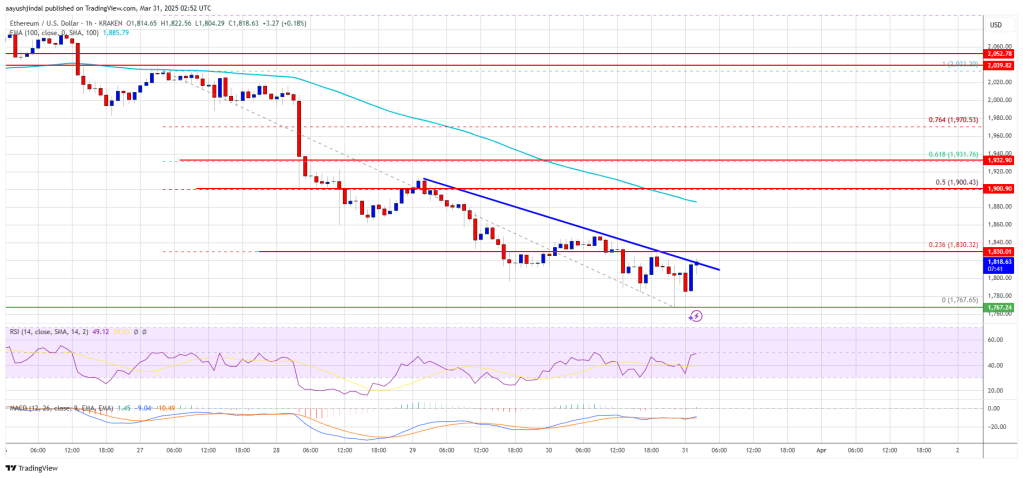
A clear move above the $1,920 resistance might send the price toward the $2,000 resistance. An upside break above the $2,000 resistance might call for more gains in the coming sessions. In the stated case, Ether could rise toward the $2,050 resistance zone or even $2,120 in the near term.
More Losses In ETH?
If Ethereum fails to clear the $1,880 resistance, it could start another decline. Initial support on the downside is near the $1,780 level. The first major support sits near the $1,765 zone.
A clear move below the $1,765 support might push the price toward the $1,720 support. Any more losses might send the price toward the $1,680 support level in the near term. The next key support sits at $1,650.
Technical Indicators
Hourly MACD – The MACD for ETH/USD is losing momentum in the bearish zone.
Hourly RSI – The RSI for ETH/USD is now below the 50 zone.
Major Support Level – $1,765
Major Resistance Level – $1,880
Market
Bitcoin Bears Tighten Grip—Where’s the Next Support?

Reason to trust

Strict editorial policy that focuses on accuracy, relevance, and impartiality
Created by industry experts and meticulously reviewed
The highest standards in reporting and publishing
Strict editorial policy that focuses on accuracy, relevance, and impartiality
Morbi pretium leo et nisl aliquam mollis. Quisque arcu lorem, ultricies quis pellentesque nec, ullamcorper eu odio.
Bitcoin price started another decline below the $85,000 zone. BTC is now consolidating and might struggle to recover above the $83,500 zone.
- Bitcoin started a fresh decline below the $83,500 support zone.
- The price is trading below $83,200 and the 100 hourly Simple moving average.
- There is a connecting bearish trend line forming with resistance at $82,750 on the hourly chart of the BTC/USD pair (data feed from Kraken).
- The pair could start another decline if it stays below the $83,500 resistance zone.
Bitcoin Price Dips Further
Bitcoin price failed to remain above the $85,500 level. BTC started another decline and traded below the support area at $85,000. The bears gained strength for a move below the $83,500 support zone.
The price even declined below the $82,000 level. A low was formed at $81,586 and the price is now consolidating losses below the 23.6% Fib retracement level of the downward move from the $83,500 swing high to the $81,586 swing low.
Bitcoin price is now trading below $82,500 and the 100 hourly Simple moving average. On the upside, immediate resistance is near the $82,000 level. The first key resistance is near the $82,750 level. There is also a connecting bearish trend line forming with resistance at $82,750 on the hourly chart of the BTC/USD pair.
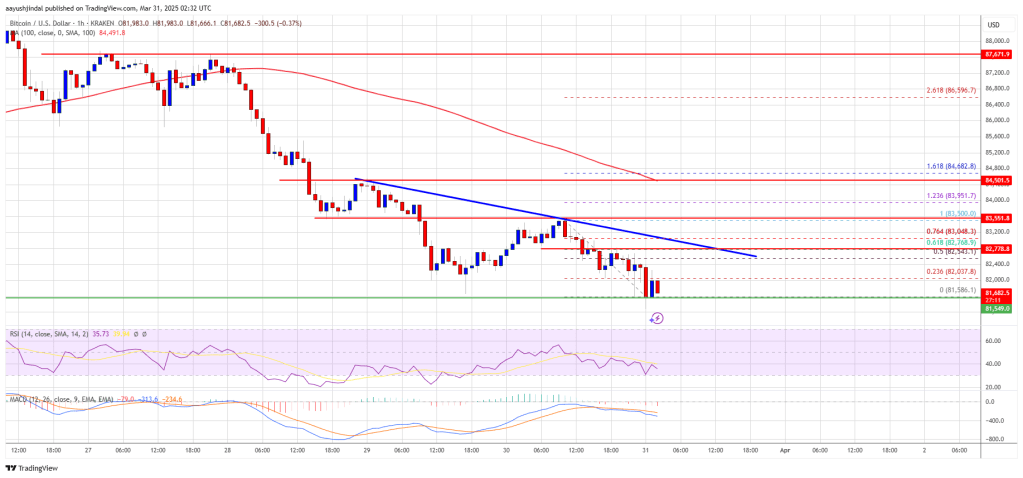
The trend line is near the 61.8% Fib retracement level of the downward move from the $83,500 swing high to the $81,586 swing low. The next key resistance could be $83,500. A close above the $83,500 resistance might send the price further higher. In the stated case, the price could rise and test the $84,200 resistance level. Any more gains might send the price toward the $84,800 level or even $85,000.
Another Decline In BTC?
If Bitcoin fails to rise above the $83,500 resistance zone, it could start a fresh decline. Immediate support on the downside is near the $81,800 level. The first major support is near the $81,500 level.
The next support is now near the $80,650 zone. Any more losses might send the price toward the $80,000 support in the near term. The main support sits at $78,500.
Technical indicators:
Hourly MACD – The MACD is now gaining pace in the bearish zone.
Hourly RSI (Relative Strength Index) – The RSI for BTC/USD is now below the 50 level.
Major Support Levels – $81,500, followed by $80,650.
Major Resistance Levels – $82,750 and $83,500.
-

 Ethereum16 hours ago
Ethereum16 hours agoWhales Accumulate 470,000 Ethereum In One Week – Bullish Momentum Ahead?
-

 Market19 hours ago
Market19 hours agoWhale Leverages $27.5 Million PEPE Long on Hyperliquid
-

 Ethereum18 hours ago
Ethereum18 hours agoEthereum May Have Hit Cycle Bottom, But Pricing Bands Signal Strong Resistance At $2,300
-

 Ethereum17 hours ago
Ethereum17 hours agoEthereum Analyst Eyes $1,200-$1,300 Level As Potential Acquisition Zone – Details
-

 Bitcoin17 hours ago
Bitcoin17 hours agoGold Keeps Outperforming Bitcoin Amid Trump’s Trade War Chaos
-
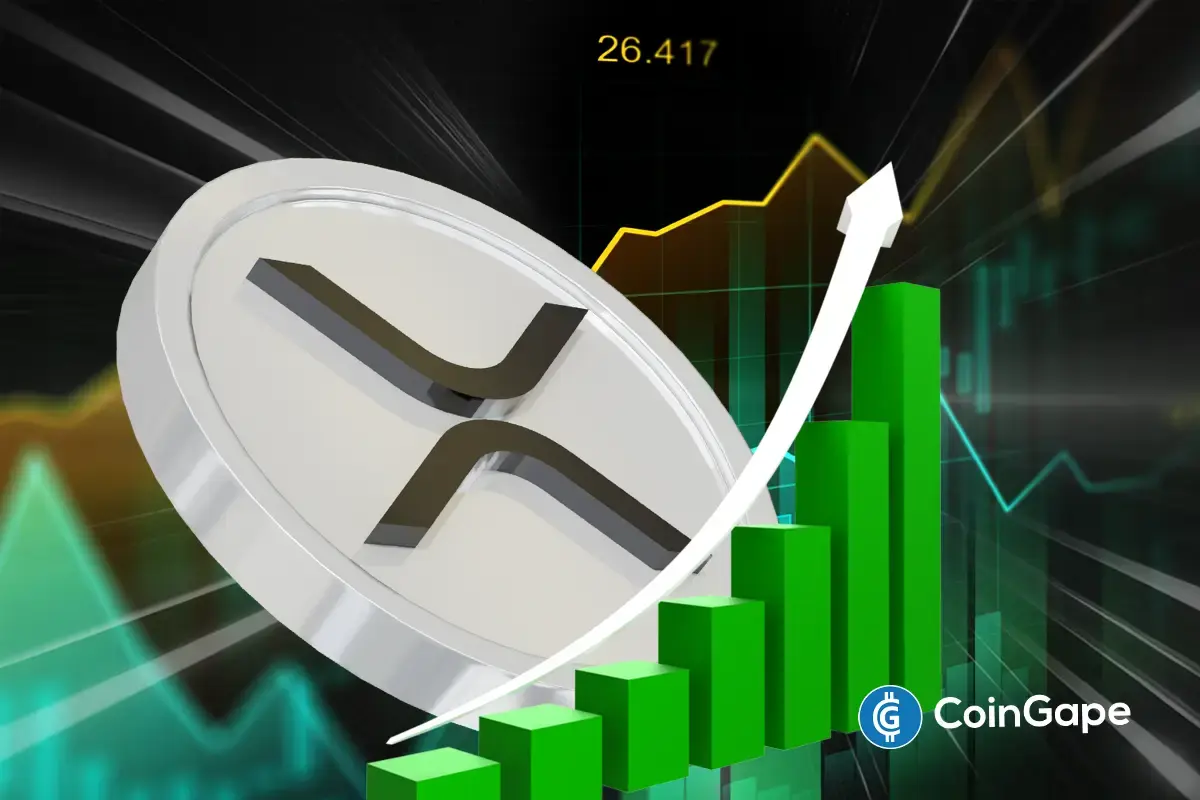
 Altcoin16 hours ago
Altcoin16 hours agoAnalyst Reveals Why The XRP Price Can Hit ATH In The Next 90 To 120 Days
-

 Bitcoin23 hours ago
Bitcoin23 hours agoWhy Bitcoin Seasoned Investors Are Accumulating — Analyst Evaluates BTC’s Current Phase
-
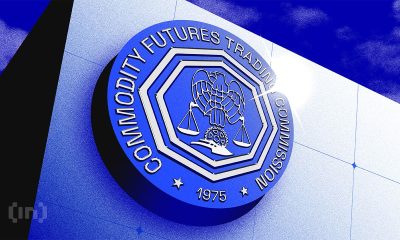
 Market23 hours ago
Market23 hours agoCrypto Derivatives Get a Boost from US CFTC
























